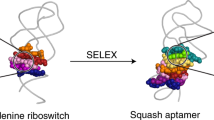Abstract
We report the design, synthesis, and characterization of a molecular beacon (MB) consisting of two fluorescent dyes (Alexa 488 and RedX) for DNA and RNA analysis. In the absence of the target DNA or RNA the MB is in its stem-closed form and shows efficient energy transfer from the donor (Alexa) to the acceptor (RedX), generating mostly fluorescence from RedX. In the presence of the complementary target DNA the MB opened efficiently, hybridizes with the target DNA, and energy transfer is blocked in the stem-open form. This attachment to the target generates a fluorescence signature, which is clearly distinguishable from the fluorescence signature of the stem-closed form, allowing for ratiometric analysis of the fluorescence signal. In addition to steady-state fluorescence analysis, time resolved fluorescence (ps time range) and fluorescence depolarization studies were performed. We show that fluorescence lifetime and fluorescence depolarization measurements are useful analytical tools to optimize the MB design.
Similar content being viewed by others
References
W. Tan, X. Fang, J. Li and X. Liu, Molecular beacons: a novel DNA probe for nucleic acid and protein studies, Chem.–Eur. J., 2000, 6, 1107–1111.
T. Antony and V. Subramaniam, Molecular Beacons: Nucleic Acid Hybridization and Emerging Applications, J. Biomol. Struct. Dyn., 2001, 19, 4997–5004.
G. Bonnet, S. Tyagi, A. Libchaber and F. R. Kramer, Thermodynamic basis of the enhanced specificity of structured DNA probes, Proc. Natl. Acad. Sci. U. S. A., 1999, 96, 6171–6176.
S. Tyagi and F. R. Kramer, Molecular Beacons: Probes that Fluoresce upon Hybridization, Nat. Biotechnol., 1996, 14, 303–308.
S. Tyagi, D. P. Bratu and F. R. Kramer, Multicolor molecular beacons for allele discrimination, Nat. Biotechnol., 1998, 16, 49–58.
K. Faulds, L. Fruk, D. C. Robson, D. G. Thompson, A. Enright, W. E. Smith and D. Graham, A new approach for DNA detection by SERRS, Faraday Discuss., 2006, DO: 10.1039/b506219e.
G. Bonnet, O. Krichevsky and A. Libchaber, Kinetics of confor-mational fluctuations in DNA hairpin-loops, Proc. Natl. Acad. Sci. U. S. A., 1998, 95, 8602–8606.
S. A. E. Marras, F. R. Kramer and S. Tyagi, Efficiencies of fluorescence resonance energy transfer and contact-mediated quenching in oligonucleotide probes, Nucleic Acids Res., 2002, 30, e122.
P. Zhang, T. Beck and W. Tan, Design of a Molecular Beacon DNA Probe with Two Fluorophores, Angew. Chem., Int. Ed., 2001, 40, 402–405.
A. A. Martí, S. Jockusch, Z. Li, J. Ju and N. J. Turro, Molecular Beacons with intrinsically fluorescent nucleotides, Nucleic Acids Res., 2006, accepted, DOI: 10.1093/nar/gkl134.
K. Fujimoto, H. Shimizu and M. Inouye, Unambiguous Detection of Target DNAs by Excimer-Monomer Switching Molecular Beacons, J. Org. Chem., 2004, 69, 3271–3275.
C. J. Yang, S. Jockusch, M. Vincens, N. J. Turro and W. Tan, Light-switching excimer probes for rapid protein monitoring in complex biological fluids, Proc. Natl. Acad. Sci. U. S. A., 2005, 102, 17278–17283.
S. A. E. Marras, F. R. Kramer and S. Tyagi, Genotyping single nucleotide polymorphisms with molecular beacons, The Humana Press Inc., Towada, NJ, 2003, vol. 212, pp. 111–128.
J.-F. Brunet, E. Shapiro, S. A. Foster, E. R. Kandel and Y. Iino, Identification of a peptide specific for Aplysia sensory neurons by PCR-based differential screening, Science, 1991, 252, 856–859.
N. Panchuk-Voloshina, R. P. Haugland, J. Bishop-Stewart, M. K. Bhalgat, P. J. Millard,.F Mao, W.-Y. Leung and R. P. Haugland, Alexa dyes, a series of new fluorescent dyes that yield exceptionally bright, photostable conjugates, J. Histochem. Cytochem., 1999, 47, 1179–1188.
A. M. Iribarren, B. S. Sproat, P. Neuner, I. Sulston, U. Ryder and A. I. Lamond, 2’-O-alkyl oligoribonucleotides as antisense probes, Proc. Natl. Acad. Sci. U. S. A., 1990, 87, 7747–7751.
P. Bratu Diana, B.-J. Cha, M. Mhlanga Musa, R. Kramer Fred and S. Tyagi, Visualizing the distribution and transport of mRNAs in living cells, Proc. Natl. Acad. Sci. U. S. A., 2003, 100, 13308–13313.
A. I. Lamond and B. S. Sproat, Antisense oligonucleotide made of 2’-O-AlkylRNA: their properties and applications in RNA biochemistry, FEBS Lett., 1993, 1-2, 123–127.
T. Heinlein, J.-P. Knemeyer, O. Piestert and M. Sauer, Photoinduced Electron Transfer between Fluorescent Dyes and Guanosine Residues in DNA-Hairpins, J. Phys. Chem. B, 2003, 107, 7957–7964.
K. Stoer, B. Haefner, O. Nolte, J. Wolfrum, M. Sauer and D.-P. Herten, Species-Specific Identification of Mycobacterial 16S rRNAS PCR Amplificons Using Smart Probes, Anal. Chem., 2005, 77, 7195–7203.
Nazarenko, R. Pires, B. Lowe, M. Obaidy and A. Rashtchian, Effect of primary and secondary structure of oligodeoxyribonucleotides on the fluorescent properties of conjugated dyes, Nucleic Acids Res., 2002, 30, 2089–2195.
E. Rusinova, V. Tretyachenko-Ladokhina, O. E. Vele, D. F. Senear and J. B. A. Ross, Alexa and Oregon Green dyes as fluorescence anisotropy probes for measuring protein-protein and protein-nucleic acid interactions, Anal. Biochem., 2002, 308, 18–25.
R. A. Hochstrasser, S.-M. Chen and D. P. Millar, Distance distribution in a dye-linked oligonucleotide determined by time-resolved fluorescence energy transfer, Biophys. Chem., 1992, 45, 133–141.
J. R. Lakowicz, Topics in Fluorescence Spectroscopy Volume 5: Nonlinear and Two-Photon-Induced Fluorescence, Plenum Press, New York, 1997, vol. 5, 544 pp.
A. Tsourkas, M. A. Behlke, Y. Xu and G. Bao, Spectroscopic features of dual fluorescence/luminescence resonance energy-transfer molecular beacons, Anal. Chem., 2003, 75, 3697–3703.
Author information
Authors and Affiliations
Additional information
Electronic supplementary information (ESI) available: Details of the synthesis of the MB, UV-Vis absorption spectra of the MBs (Fig. S1), fluorescence spectra of Alexa–MB and MB–RedX (Fig. S2), target DNA concentration dependence (Fig. S3), and no interaction of the MB with non-complementary target DNA (Fig. S4). See do]10.1039/b600213g
Rights and permissions
About this article
Cite this article
Jockusch, S., Martí, A.A., Turro, N.J. et al. Spectroscopic investigation of a FRET molecular beacon containing two fluorophores for probing DNA/RNA sequences†. Photochem Photobiol Sci 5, 493–498 (2006). https://doi.org/10.1039/b600213g
Received:
Accepted:
Published:
Issue Date:
DOI: https://doi.org/10.1039/b600213g




